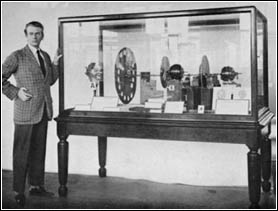|
| ||
|
Although he was relatively unknown during his own lifetime, Scottish inventor John Logie Baird was definitely one of the most influential men of the twentieth century. As the man who discovered television, Baird's pioneering innovations paved the way for the technological world we live in today. John Logie Baird was born in the town of Helensburgh in 1888. His talents as an innovator were evident from an early age. While only in seventh grade, he was able to connect several houses in his town together via telephone with an electric exchange of his own construction. He later re-used the components of this setup to wire his family's house, making it the first home in Helensburgh to have electric lights.
Since the invention of the telephone by fellow Scot, Alexander Graham Bell, people had struggled with the problem of transmitting live pictures across the by wireless means. Moving to London to pursue his interest in new
Because he funded this project almost entirely by himself (and he was by no means wealthy at the time), Baird was forced to make do with components that were somewhat less than cutting-edge. His original television included such things as a tin biscuit mix box, darning needles, used motors, surplus army equipment left over from WWI, and a bicycle headlight. Despite this, his contraption actually worked and on October 2nd, 1925, he sent and received the first wireless television signal (of a ventriloquist's dummy). A few months later on January 26th, 1926, he made a live demonstration to the British public. Baird achieved another first several years later when he transmitted live images of himself, along with the aforementioned puppet, across the Atlantic to be received in New York on February 9th, 1928. The BBC took interest in his invention and used it for experimental broadcasts for several years beginning in 1929. It is estimated that at its peak, about three thousand people owned Baird Televisions and faithfully watched the BBC broadcasts, but his technology was replaced in 1933 by more sophisticated systems, such as the EMI or "Electronic Scanning System". Although his invention didn't make him much money, but Baird's innovation did help pave the way for more advanced devices. While modern television bears little in common with the bulky construct used to receive images of a puppet in 1925 (although some may argue that the broadcast content hasn't improved much), some of the technology still lives on today in other technology. The method employed in the modern computer mouse to track the mouse ball is actually based on Baird's pioneering work with the Nipkow disk. Another device Baird pioneered was a video-recording unit that used a needle to read capacitance changes on large plastic disks. Similar techniques were later implemented with laser disks. Some of the technology behind Virtual Reality can also be traced back to Baird, who in 1946 developed something called a stereoscopic television. It was comprised of a unit that covered the user's face and basically provided once television per eye. Relatively unappreciated in his time, Baird never became wealthy from his invention, but the influence of his work is undeniable and still clearly visible today. Baird died at age 58, shortly after inventing the stereoscopic television. A book has been written on Baird's life by Ronald F. Tiltman titled Baird of Television The Life Story of John Logie Baird. There also exists a "John Logie Baird Award for Innovation" which is given to people or companies in recognition of innovation. SBB, December 1999
| ||
|
| ||
Thursday, December 26th, 2019
Attention visitors: Tartans.com is back. Please note that this is a snapshot of the site as it existed nearly 20 years ago and you may encounter broken links; we are still combing through the site and correcting those as we find them. Please also note that some sections are currently not functional, primarily the discussion forums/clan chat boards.
|
** HOME - First Time Visitors - Glossary - - Contact Us ** Awards | Bibliography | Clan Calendar | Clan Chat | Clan Finder | History | Famous Scots | Genealogy | Great Hall of the Clans | Links | News and Features | Scots on the Net | Search | Site Map The Gathering of the Clans
Copyright 1995- Tartans.com - All Rights Reserved. |

 technologies, Baird was eventually able to accomplish this goal. Basing his design on a device called the Nipkow disk (invented by German physicist Paul Nipkow to transmit moving pictures across wire), he began working on the "mechanical televisor" in his attic on the southern coast of England.
technologies, Baird was eventually able to accomplish this goal. Basing his design on a device called the Nipkow disk (invented by German physicist Paul Nipkow to transmit moving pictures across wire), he began working on the "mechanical televisor" in his attic on the southern coast of England.